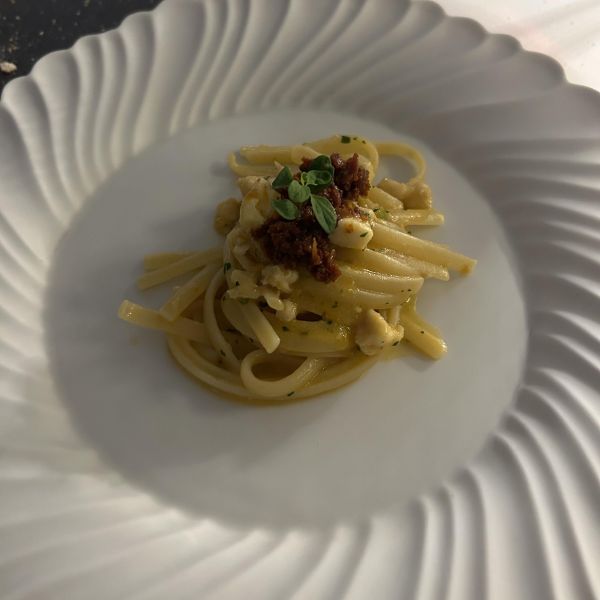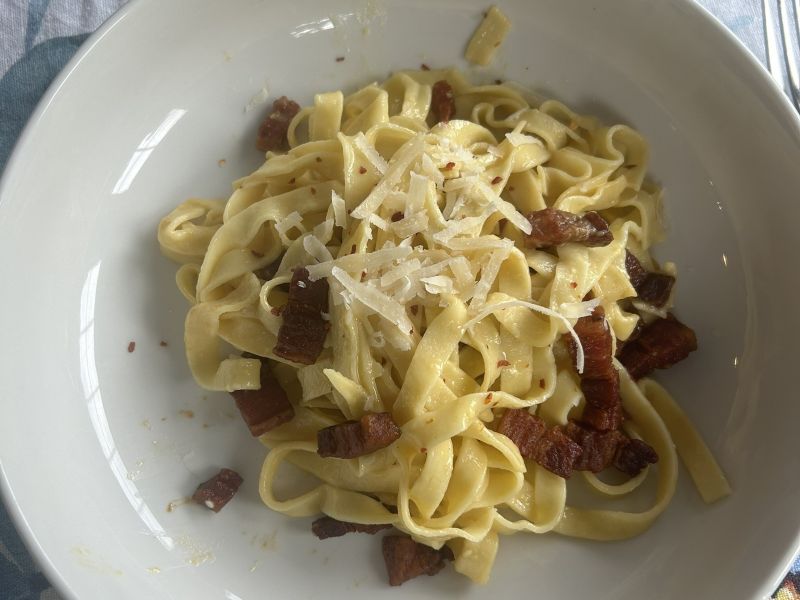This Classic Roman Carbonara is a celebration of simplicity. The dish embodies the philosophy of Italian cooking: using high-quality ingredients with precise techniques to create something truly special.
The origins of Carbonara are somewhat mysterious, but one popular theory is that it was created by Roman “carbonai” (coal workers) who needed a hearty, easy-to-make meal while working in the Apennine Mountains. Others believe it was inspired by the influx of eggs and bacon brought to Italy by American soldiers during World War II, which local chefs adapted using guanciale and Pecorino Romano instead. Regardless of its exact origins, Carbonara has become a staple of Roman cuisine, celebrated for its creamy texture—made without cream—and its perfect balance of salty, savory flavors. Today, it is one of the most iconic Italian pasta dishes, found in trattorias throughout Rome and perfected by chefs like Luciano Monosilio, the so-called “King of Carbonara.”

Carbonara has been perfected in many renowned Roman trattorias, with Trattoria Da Felice being one of the most famous spots to experience this dish in its most authentic form. Another must-visit is Roscioli, a historic deli and restaurant in Rome, known for its indulgently creamy Carbonara made with high-quality guanciale and aged Pecorino Romano. Among the chefs who have elevated this dish, Luciano Monosilio is widely recognized as the “King of Carbonara”, having perfected a precise technique that ensures the sauce is silky and rich without becoming scrambled. Beyond Italy, celebrity chefs like Stanley Tucci have helped bring Carbonara into the spotlight, showcasing its traditional preparation in his series Searching for Italy. Even Hollywood has embraced the dish—one of the most memorable food scenes in Eat Pray Love features Julia Roberts savoring a plate of Roman pasta, inspiring countless travelers to seek out the real thing in the Eternal City.

Ready to twirl your fork like a Roman? If you’re planning a trip to Italy, don’t miss the chance to master the art of Carbonara where it was born! Book a hands-on cooking class in Rome and learn from real Italian chefs how to perfect this creamy, peppery, pancetta-laced masterpiece.
Book your Roman Carbonara cooking class here – your taste buds will thank you!

Classic Roman Carbonara
Equipment
- 1 Large pot for boiling water for pasta
- 1 Large skillet or pan
- 1 Tongs or pasta fork
- 1 Mixing bowl
- Whisk
- Cheese grater
Ingredients
- 12 oz Tonnarelli or Spaghetti I like Bucatini
- 4 oz Guanciale (diced or large sliced) Pancetta can be substituted
- 2 Large eggs Room temperature
- 2 Egg yolks Room temperature
- 1 cup Pecorino Romano cheese Finely grated
- Salt For pasta water
- Pepper As needed
Instructions
Prepare the Guanciale
- Cut guanciale into small matchstick pieces. In a cold skillet, add guanciale and turn heat to medium-low. Slowly cook for 4–5 minutes until crispy and golden. Remove from heat, leaving the fat in the pan. Let it cool slightly to avoid scrambling the eggs later.
Cook the Pasta
- Bring a large pot of salted water to a boil. (Use less salt than usual—Pecorino is salty.) Cook pasta until al dente, about 1 minute less than package instructions. Reserve 1 cup of pasta water, then drain.
Make the Sauce
- In a mixing bowl, whisk together eggs, egg yolks, Pecorino Romano, and black pepper. Add 2 tbsp of reserved hot pasta water to temper the eggs, whisking quickly.
Combine Everything
- Add hot drained pasta to the skillet with guanciale (off the heat). Pour the egg mixture over the pasta and toss quickly to coat. Add a small amount of reserved pasta water to adjust creaminess.
Serve Immediately
- Plate and top with extra Pecorino Romano and black pepper.Serve immediately—Carbonara waits for no one!
Notes
- Use guanciale, NOT bacon, for an authentic flavor.
- No cream needed! The eggs and cheese create the creamy texture.
- Work quickly when adding the egg mixture to avoid scrambling.
- Pecorino Romano > Parmesan. The sharp, salty flavor is essential.
